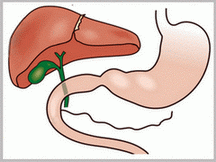
Gallbladder symptoms
Table of Contents
About me
Categories
Text
GALLSTONES
Gallstones are extremely common and will affect one in three women and one in five men. Most stones are totally asymptomatic and are found by chance during other investigations. There are three types of gallstones.
* Cholesterol stones are often solitary; they form in bile in which cholesterol is in excess relative to bile salts, and are
found in about 10% of patients with stones; they are common in women who have had many children or who have taken oral contraceptives.
* Pigment stones are usually multiple and green—black in color; they account for about 10-15% of all stones and are the result of bilirubin precipitation, caused by overproduction in chronic haemolytic states; they are later associated with recurrent ascending cholangitis.
* Mixed stones are by far the most common, are usually multiple and are a mixture of cholesterol, pigment, calcium carbonate and phosphate; they are found in people who are obese, who have taken estrogen or who have lived on a diet rich in unrefined carbohydrate and high in calories.
In most patients stones form and remain in the gallbladder without causing symptoms, but they may produce a range of symptoms, including intolerance to fatty foods, with nausea, vomiting, flatulence and epigastric pain. In a minority of patients, gallstones may be associated with significant complications.
Migration of stones may lead to additional symptoms such as colicky right hypochondrial pain, obstructive jaundice and recurrent bouts of ascending cholangitis or acute pancreatitis, or both.
Chronic cholecystitis may lead to adhesion of the gallbladder to surrounding organs, for example the small bowel, colon or
stomach, with subsequent erosion of a stone, which may then pass along the bowel and even cause intestinal obstruction if very
large. The presence of a fistula leads to recurrent ascending infections in the biliary tree. Chronic cholecystitis may lead to carcinoma of the gallbladder.
The principal mode of therapy is surgery. Gallstones may be removed by a course of extracorporeal shock-wave lithotripsy in association with oral bile acid (ursodeoxycholic acid) dissolution therapy. This is a lengthy and tedious procedure which has a 30-80% success rate after 1 year.
What are the complications of gallstone disease?
* acute cholestasis
* chronic cholecystitis
* fistula formation — gallstone ileus
* impaction of stone in common hepatic duct
* gangrene of gallbladder, perforation or empyema
* pancreatitis
Labels: Gallstones
2 Comments:

http://kidbuxblog.com/removing-gallstones-naturally/
This medicine is available in powder form n have no any side effect.After yrs.of research,we present a miracle stone dissolving package,cost 2000/-for complete course of 6 weeks treatment. Our medicine doesn't only dissolve kidney stones,instead it destroy the root causes n we guarantees that u will never get Kidney stone again in ur rest of life.If u have any query then Contact to...Dr.R.K.Rishi,BAMS,MD(A.Medicine).Varanasi. Mob. 09889971201
FOR MORE INFORMATION KINDLY CLICK HERE